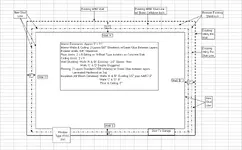T
Topcat53
New member
I know there are several threads on this topic, but it seems like the issues are different for each. I'm taking up part of my garage to build a jam space - a place to be able to turn my amps up to reasonable levels without disturbing the rest of the house and maybe do some recording. The room acoustics can come later - right now I'm wanting to make sure I get the room properly isolated. It will be about 10 x 12 with the long wall against the MBR and one short wall against the kitchen. Floor will be raised about 20" above the existing slab (house is raised foundation & garage is SOG). This will match the existing floor level of the house and without going into a lot of detail, will make the overall construction easier. The walls of the existing house inside the garage are sheetrocked with blown cellulose insulation. Here's what I'm thinking -
2 walls against existing house - studs about 1" short of touching existing sheetrock, blown cell ins, mass loaded vinyl on jam room side, then sound iso clips and sheet rock.
2 walls out into garage - basically the same except that outside will be sheetrocked
Ceiling - mass loaded vinyl on existing sheet rock, furring strips, isolation clips, new sheet rock
Floor - joists will sit on cinder blocks to raise to match existing house floor level and will insulate in between. Want hardwood flooring in the room. Beyond that I'm a little confused about how to isolate.
Door - Will go out into garage & right now I'm just planning for a good quality exterior door maybe modified with some extra sealing.
HVAC - BIG question here. Will share existing central house system (garage already does this). So how do I keep sound from travelling through ducts? Are there caps you can put on while using the room and take off when not?
Thanks in advance for any advice.
2 walls against existing house - studs about 1" short of touching existing sheetrock, blown cell ins, mass loaded vinyl on jam room side, then sound iso clips and sheet rock.
2 walls out into garage - basically the same except that outside will be sheetrocked
Ceiling - mass loaded vinyl on existing sheet rock, furring strips, isolation clips, new sheet rock
Floor - joists will sit on cinder blocks to raise to match existing house floor level and will insulate in between. Want hardwood flooring in the room. Beyond that I'm a little confused about how to isolate.
Door - Will go out into garage & right now I'm just planning for a good quality exterior door maybe modified with some extra sealing.
HVAC - BIG question here. Will share existing central house system (garage already does this). So how do I keep sound from travelling through ducts? Are there caps you can put on while using the room and take off when not?
Thanks in advance for any advice.


